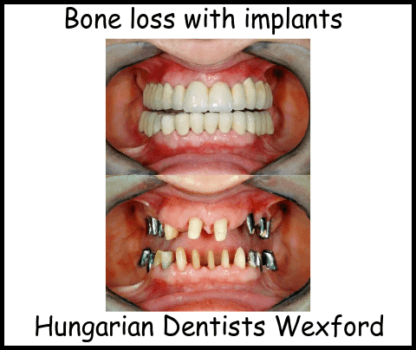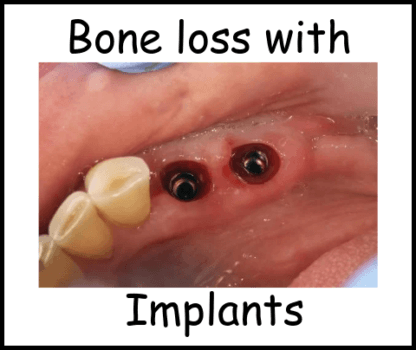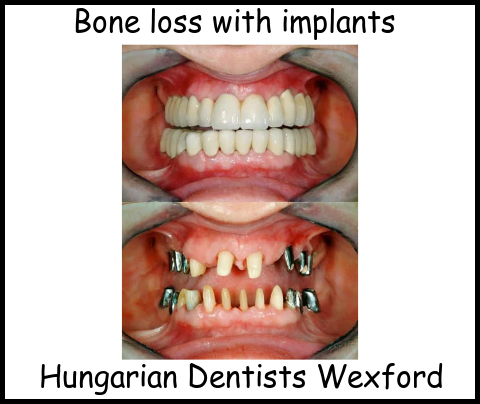Bone loss with implants
Bone loss with implants go hand in hand especially as we get a bit older, bone loss is caused by gum disease or perionditis, teeth then become loose and can fall out.
Perhaps you have missing teeth and want the option of dental implants but you want to get more information on not bone loss with implants.
In modern dentistry there are a number of options when patients don’t have sufficient bone in their gums to take a dental implant.

When were implants first introduced
When implants were first introduced way back in 2,500 BC when the ancient Egyptian population were offered a type of dental implant made from ligature wire made from gold to stabilize teeth.
In approximately 600 AD the very first dental implant was attributed to the people of Mayan where they expertly utilized pieces of shells to replace mandibular teeth.
As dental implants improved many were as long as 15mm or more in order for them to be anchored as strongly as possible to the jawbone.
Then one day it was found that the extra long implants weren’t that much stronger so a shorter implant was used in many cases.
This meant that although there may have been not bone loss for implants the smaller implants in some cases meant it was possible to complete the treatment.
The implants were as short as 5mm, but in most cases a 9mm implant would be used.
The shortest implants could be used to steer clear of nerves and significant structures.
Contact us at Hungarian Dental Implant Centre Wexford for more information on bone loss with implants and what can be done.
What is bone grafting
Bone grafting is a procedure undertaken by a dental surgeon to create bone mass in areas of the jawbone where there isn’t enough bone to take an implant. .
The material used to create extra bone is sourced from the patient’s own bone or from some external bone source like animal bone or a donor bone.
The method used via particulate bone is called guided bone rejuvenation using the “sausage technique” in some cases a block of bone like a ring or bone graft is used.
A bone graft is an advanced treatment technique that is carried out for maximum patient comfort under a moderate sedation.
During the integration of the bone graft a temporary denture or bridge is provided to allow normal functioning of teeth.
Once the issue of not enough bone for implants has been fixed by bone grafting the dental implants can be introduced into the new bone structure to become a solid foundation for new teeth.
The purpose is to ensure a long-term under-structure of both gum and bone around the implants.
Graft free implant options
There is a process involving all-on-4 implants where if possible a suitably prepared or inclined implants can make very good use of limited bone that is available to take new teeth.
The All-on-4 process can be a suitable option in cases like this.
If you are in a situation where there is bone loss for implants contact Fintan on 0873490104 to arrange a free consultation.
Why not explore the best options for you by chatting to our Hungarian dentist in Wexford town clinic.

Bone loss dental implants
When teeth fall out or because of trauma following an accident bone loss can occur over time.
The more time that elapses the more bone loss there is.
Bone loss impacts people in different ways, wearing dentures is not ideal because it can hasten the quantity of bone loss.
In a case where there is significant bone loss, the remaining bone isn’t sufficient to hold a dental implant then it will be necessary to consider a bone graft.
In most cases this important but simple procedure can be carried out using a local anesthetic.
However in the more severe situations a hospital visit may be required where a general anesthetic is used.
Minor swelling
Following the initial assessment in our state-of-the-art dental in Hungary Perfect Smile the amount of bone will be measured using a CT dental scan.
There are a number of bone grafting options, all will involve minor swelling for a week to go weeks, medication can be used to help with swelling.
Bone loss for implants solution
Implant dentistry has significantly advanced over the years, offering patients a reliable and long-lasting solution for tooth replacement.
However, in some cases, patients may present with not enough bone for implants or insufficient bone volume, making traditional implant placement challenging.
This article aims to explore alternative treatment options for individuals who do not have enough bone for implants, allowing dental professionals to provide effective solutions for their patients.
1. Bone Loss Implants Techniques:
One of the most common approaches to address bone loss for implants is bone grafting.
This procedure involves transplanting bone from another part of the body, a donor, or synthetic materials to augment the existing bone volume in the implant site.
Various bone grafting techniques, such as autogenous, allograft, and xenograft grafts, can be utilized depending on the patient’s specific indication and requirements.
Bone grafting allows for predictable regeneration of bone, providing a suitable environment for implant placement.

2. Ridge Expansion:
Ridge expansion is another technique used to increase bone width in cases with narrow ridges.
By using specialized instruments, the ridge is expanded to create more space for implant placement.
This technique not only widens the bone but also enhances its density, improving the long-term success of the implant restoration.
3. Sinus Lift with bone loss
Maxillary posterior areas often experience bone loss, leading to not enough bone for implants.
A sinus lift, also known as a sinus augmentation, addresses this issue by elevating the sinus membrane and augmenting the bone beneath it.
This procedure creates a stable foundation for implant placement in the posterior maxilla and opens up new possibilities for patients who were previously considered ineligible for implants.
4. Short Implants:
When vertical bone height is limited, short implants can be considered as an alternative solution.
These implants are designed to be shorter in length, allowing for placement in areas with limited bone availability.
Short implants offer comparable success rates to conventional implants and reduce the need for invasive procedures or additional grafting.
5. Zygomatic Implants:
For patients with severe bone loss in the upper jaw, zygomatic implants provide a viable treatment option.
These implants are anchored in the cheekbone (zygomatic process) rather than the maxilla, utilizing the dense bone structure for stability.
Zygomatic implants can overcome the limitations associated with inadequate bone in the upper jaw, offering patients a predictable and functional tooth replacement solution.
Conclusion:
Not enough bone for implants placement no longer limits the options available to patients seeking tooth replacement.
With advances in bone grafting techniques, ridge expansion, sinus lifts, short implants, and zygomatic implants.
Dental professionals can effectively address bone deficiencies and provide patients with suitable alternatives to traditional implant placement.
Contact Fintan on 0873490104 at Hungarian Dental Implant Centre Wexford town for more info on not enough bone for implants and your cheapest and best options.
By staying informed about these techniques, clinicians can expand their treatment options and deliver optimal oral rehabilitation outcomes for their patients.
References


